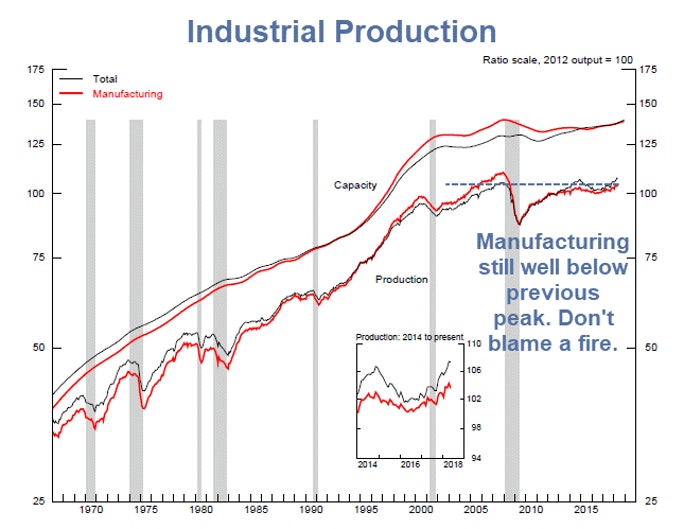The WSJ says "factory activity heats up". Really?
The Wall Street Journal reports Factory Activity Heats Up as Manufacturers Position for Tariffs.
American factory activity accelerated for the second straight month this summer, in part because manufacturers were scrambling to move goods ahead of threatened tariffs.
The Institute for Supply Management on Monday said its manufacturing index rose to 60.2 in June from 58.7 in May. Numbers above 50 indicate activity is expanding across the manufacturing sector, while numbers below 50 signal contraction. The overall ISM index in February hit 60.8, its highest level since May 2004, before easing in March and April. It picked up in May and again in June.
“There’s an extreme amount of activity going on to account for impacts that are driven by the aluminum and steel tariffs, and that is expanding out to other industries,” said Tim Fiore, who oversees the ISM survey of factory purchasing and supply managers.
“Contingency planning [for tariffs] is consuming large amounts of manpower that could be used for more productive projects,” a manufacturer told ISM. “It’s introducing a bunch of inefficiencies,” Mr. Fiore added.
“When suppliers are delivering, manufacturers are pretty much using those supplies right away,” Mr. Fiore said. “At what point does that affect output because you don’t have enough raw materials to satisfy your production?”
Actual Factory Production
Industrial production shrank in May. Manufacturing production is still well below the previous peak.
The Fed blamed a fire. It may as well have blamed the weather.
ISM anecdotes and diffusion indexes are one thing. Actual production is another.
That said, the manufacturing trend is indeed up, albeit far less than one might expect from ISM and a myriad of Beige Book anecdotes.
Let's Assume
Let's assume the ISM anecdotes are 100% accurate. What do we have?
We have a rush to get supplies to beat Trump tariffs and retaliations that are guaranteed to slow the global economy.
On April 18, I noted Fed's Beige Book Notes "Dramatic" Increases in Prices Due to Tariffs.
A day later, I dug a bit deeper with Fantasyland Reality Check.
ISM a Leading Indicator?
On March 2, following a lunch with Jim Bianco at Bianco Research, I asked ISM a Leading Indicator? Of What?
Bianco says the "ISM is distorted not only by the survivor bias but by answering bias." He stopped responding years ago.
Nonetheless, let's give the ISM anecdotes the benefit of the doubt. Is a rush to beat tariffs, indicative of "activity heating up"?
This material is based upon information that Sitka Pacific Capital Management considers reliable and endeavors to keep current, Sitka Pacific Capital Management does not assure that this material is accurate, current or complete, and it should not be relied upon as such.
Recommended Content
Editors’ Picks
AUD/USD jumps above 0.6500 after hot Australian CPI data

AUD/USD extended gains and recaptured 0.6500 in Asian trading, following the release of hotter-than-expected Australian inflation data. The Australian CPI rose 1% in QoQ in Q1 against 0.8% forecast, providing extra legs to the Australian Dollar upside.
USD/JPY hangs near 34-year high at 154.88 as intervention risks loom

USD/JPY is sitting at a multi-decade high of 154.88 reached on Tuesday. Traders refrain from placing fresh bets on the pair as Japan's FX intervention risks loom. Broad US Dollar weakness also caps the upside in the major. US Durable Goods data are next on tap.
Gold price cautious despite weaker US Dollar and falling US yields

Gold retreats modestly after failing to sustain gains despite fall in US Treasury yields, weaker US Dollar. XAU/USD struggles to capitalize following release of weaker-than-expected S&P Global PMIs, fueling speculation about potential Fed rate cuts.
Crypto community reacts as BRICS considers launching stablecoin for international trade settlement

BRICS is intensifying efforts to reduce its reliance on the US dollar after plans for its stablecoin effort surfaced online on Tuesday. Most people expect the stablecoin to be backed by gold, considering BRICS nations have been accumulating large holdings of the commodity.
US versus the Eurozone: Inflation divergence causes monetary desynchronization

Historically there is a very close correlation between changes in US Treasury yields and German Bund yields. This is relevant at the current juncture, considering that the recent hawkish twist in the tone of the Fed might continue to push US long-term interest rates higher and put upward pressure on bond yields in the Eurozone.
